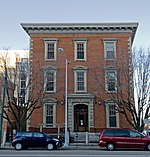Temple Israel (Dayton, Ohio)

Temple Israel is a Reform Jewish congregation and synagogue, located at 130 Riverside Drive in Dayton, Ohio, in the United States. Formed in 1850, it incorporated as "Kehillah Kodesh B'nai Yeshurun" in 1854. After meeting in rented quarters, the congregation purchased its first synagogue building, a former Baptist church at 4th and Jefferson, in 1863. Strongly influenced by Rabbi Isaac Mayer Wise, it rapidly modernized its services, and, in 1873, was a founding member of the Union for Reform Judaism.The congregation sold its existing building in 1893, and constructed a larger one at First and Jefferson, later severely damaged by the Great Dayton Flood of 1913. In 1927, the congregation moved to still larger, multi-purpose premises at Salem and Emerson Avenues, outside downtown Dayton, and began to use the name "Temple Israel", adding a new sanctuary to the building in 1953. Temple Israel moved to its current building in 1994.Synagogue membership grew steadily for over 100 years, from 12 families in 1850 to 150 in the early 1900s, 200 by 1927, and 500 by 1945, peaking at 1,100 in the 1960s. By 1995, however, membership was down to 800 families.Temple Israel has had a number of long-tenured rabbis who were influential both in the congregation and in the larger Dayton community. These have included David Lefkowitz (1900–1920), Louis Witt (1927–1947), Selwyn Ruslander (1947–1969) and P. Irving Bloom (1973–1997). As of 2011, the rabbis were David M. Sofian and Karen Bodney-Halasz.
Excerpt from the Wikipedia article Temple Israel (Dayton, Ohio) (License: CC BY-SA 3.0, Authors, Images).Temple Israel (Dayton, Ohio)
All Veterans Walkway, Dayton
Geographical coordinates (GPS) Address Nearby Places Show on map
Geographical coordinates (GPS)
| Latitude | Longitude |
|---|---|
| N 39.768979 ° | E -84.189906 ° |
Address
All Veterans Walkway
45423 Dayton
Ohio, United States
Open on Google Maps









